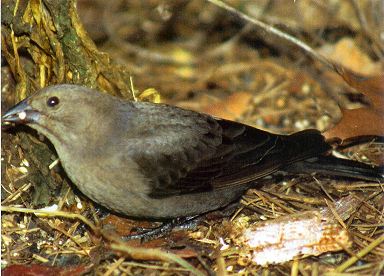|
Brown-headed Cowbird Molothrus ater Vaquero Cabecipardo,
|
 |
|
Male/Macho - Photo/Foto: G. Beaton
|
|
Brown-headed Cowbird Molothrus ater Vaquero Cabecipardo,
|
 |
|
Male/Macho - Photo/Foto: G. Beaton
|
TAXONOMY/ TAXONOMÍA: PASSERIFORMES; ICTERIDAE. |
||
 |
|
Male/Macho - Photo/Foto: G. Beaton
|
 |
|
Male/Macho - Photo/Foto: J. Wilson
|
 |
|
Female/Hembra - Photo/Foto: J. Wilson
|
|
References/Referencias Banks, A. J. and T. E. Martin. 2001. Host activity and the risk of nest parasitism by brown-headed cowbirds. Behav. Ecol. 12:31-40. Bent, A.C. 1958. Life histories of North American blackbirds, orioles, tanagers, and allies. Smithsonian Instit. U.S. National Museum Bull. 211. (Reprinted by Dover Press, NY, 1965). Cooper, B. G. and F. Goller. 2004. Multimodal signals: enhancement and constraint of song motor patterns by visual display. Science 303:544-546. Ehrlich, P.R., D.S. Dobkin, and D. Wheye. 1988. The birder’s handbook: a field guide to the natural history of North American birds. Simon and Schuster/ Fireside, NY. Lowther, P. E. 1993. Brown-headed Cowbird (Molothrus ater). No. 47 in The birds of North America (A. Poole and F. Gill, eds.). Acad. Nat. Sci., Philadelphia, PA, and Am. Ornithol. Union, Washington, D.C. |
|
Use the "Back" button on your browser to return to the previous page. |
Use el botón "Back" en su navegador para volver al texto principal |